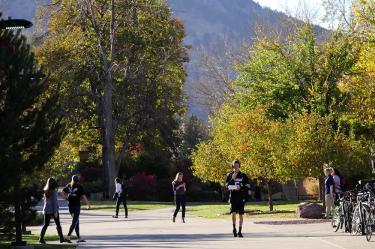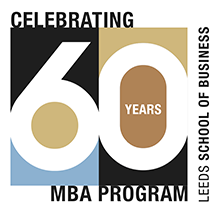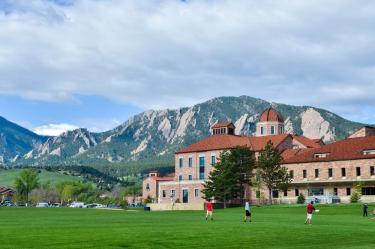Content Style Guide
Your Main Reference for Style Questions
To take the guesswork out of editorial style decisions, both Leeds and CU Boulder use The Associated Press Stylebook as our official style guide, which is reflected in the CU Boulder Style Guidelines. Refer to the Merriam-Webster Dictionary for additional spelling and usage questions.
See CU Boulder's guidelines for:
CU Boulder Word List
Digital Accessibility
Exceptions to AP Style
Inclusive Language
Leeds-Specific Guidelines and Common Questions
The following guidelines represent Leeds-specific styles and common sticking points. As language itself is always evolving, issues of style are also in constant flux. Our goal is to provide clear, simple guidelines for capitalization, punctuation, spelling, grammar and usage to ensure the highest standards of quality in all of our communications. Remember to bookmark this page for regular use.
Have a style-related question or an update? Please contact Jane Majkiewicz.
Acronyms
In general, spell out acronyms on first reference with the acronym in parentheses. Use the acronym thereafter.
Apostrophes
Leeds’, not Leeds’s. Often, you will find that we don't use a possessive form for Leeds; for example, Leeds students, Leeds faculty, Leeds courses, Leeds alumni, Leeds Business Insights. BUT: Leeds’ Strategic Plan.
Capitalization
Title case means the first letter of each word is capitalized, except for certain small words such as articles and short prepositions (a, an, as, the, and, but, for, nor, or, to, of.) Example: This Is Title Case.
Sentence case means you capitalize the first word and proper nouns, as you would in a normal sentence. Example: This is sentence case.
- Use title case for website headlines, page titles, section titles on a webpage, news story headlines, slider headlines, sidebars, navigation links and call-to-action buttons. Use sentence case in all other instances in writing for the web.
- Use title case for headlines in print and email. Use sentence case for everything else, including subheads and section titles. Format email addresses in all lowercase. Examples: leedsambassadors@gmail.com, john.smith@colorado.edu.
Centers of Excellence
- Burridge Center for Finance (Burridge Center or Burridge after first reference)
- Business Research Division (BRD)
- Center for Ethics and Social Responsibility (CESR)
- Center for Research on Consumer Financial Decision Making (CFDM)
- Deming Center for Entrepreneurship (Deming Center or Deming)
- Michael A. Klump Center for Real Estate (Klump Center)
Colon
Use a colon to introduce a series or a list, especially a list preceded by as follows or the following.
Use a colon to introduce an explanatory phrase or sentence. Capitalize the first word after a colon only if it is a proper noun or the start of a complete sentence.
- Conference participants should bring the following items: laptop computer, notebook and business cards.
- The implication of the chancellor's challenge was clear: Students must not be overburdened by bureaucracy if they are to enjoy a fulfilling educational experience.
Comma
We do not use the serial comma (also referred to as Oxford or Harvard comma). A serial comma is used to separate the second-to-last item in a list from a final item introduced by the conjunction and or or. Use a serial comma only if necessary for clarity and to avoid ambiguity. Example: John bought milk, eggs and apples. But: John bought milk for his cat, kibble and bones for his dog, and birdseed for his parrot.
See the Punctuation section in CU Boulder's guidelines for a complete list of rules for commas.
Commonly misspelled words
- CU standardizes on advisor, not adviser
- In general, AP Style is to not hyphenate words with prefixes and suffixes including multi, non, pre, re, wide, etc.; for example, campuswide, nonprofit, preregister, yearlong.
Dates and Times
- Avoid ordinal numbers: August 9, 2024, not August 9th, 2024
- Use a.m. or p.m.(with periods) and no zeroes; 9 a.m., not 9:00 a.m.
- Present date ranges with an en dash: The 2012–13 academic year, not 2012-2013.
Degrees
See official CU degree abbreviations and follow CU’s rules. All Leeds undergraduate students receive a Bachelor of Science in Business Administration. Additionally, students choose academic areas of emphasis. Use the following guidelines to indicate specializations.
- Omit periods from abbreviations of academic degrees (BA, BS, MA, PhD, MBA, JD).
- Capitalize the formal names of degrees: Bachelor of Arts, Master of Science
- Use lowercase and an apostrophe with bachelor’s degree, master’s degree and lowercase doctorate or doctoral degree.
- Do not indicate a certificate or a minor in line with a degree; add it to the body content.
Bachelor’s Degrees
Acct’21, Bus’21, BS’21, Fin’21, Mktg’21, Mgmt’21, MIS’26, RelEst’21, SupCha’26, StrEnt’26, SustBus’26
Master’s Degrees
MAcct’21, MFin’21, MRelEst’21, MSupCha’21, MBusAn’21, MSSB’28
Graduate Degrees
Full-time, Evening, Hybrid and Executive MBA students earn an MBA’21. In some cases, Executive MBA is abbreviated to EMBA.
For degrees that are graduate or doctorate level, an “M” or “PhD” is put in front of the degree. Example: a master’s in English in 2009 is (MEngl’09)
Essential and Nonessential Clauses (or restrictive and nonrestrictive clauses)
This is a common area of confusion.
Example: Join us October 16 in New York as Joe Ramsey discusses his book, Digital Wasteland.
Using the comma indicates that Ramsey has written just one book. The title is a nonessential phrase, and nonessential phrases are set off with commas.
Example: Join us October 16 as Joe Ramsey discusses his documentary Digital Wasteland, the third film in a series about online activity.
In the case of more than one movie, the specific title is an essential phrase because it specifies which of the filmmaker's multiple movies you’re talking about. Essential phrases are not set off with commas.
Faculty Divisions
Use initial caps for areas of expertise, divided by commas, not semicolons: Finance, Economics, Marketing.
Locations
Include a city and state spelled out (not a postal code). In AP style, you don't need to include the state for 30 well-known cities, including Atlanta, Boston, Chicago, Dallas, Denver, Detroit, Los Angeles, Miami, New York, San Francisco, and Washington, D.C.
Numbers
- Spell out numbers under 10, except for age, credits, percentages and number lists.
- Use a comma for large numbers: 1,600, not 1600.
Quotes and Quotation Marks
- Use past tense for attribution (said, recalled, noted, mentioned, etc.).
- The period and the comma always go within quotation marks. The dash, the semicolon, the colon, the question mark and the exclamation point go within the quotation marks when they apply to the quoted matter only. They go outside when they apply to the whole sentence.
- Use single quote marks in headlines or for a quote within a quote.
Seasons and Semesters
All lowercase: spring semester; fall 2024; summer 2025 term; summer session; spring break.
Titles
Professional titles are capped only if they precede a name: Associate Editor John Smith; John Smith, associate editor. Avoid courtesy titles such Mr., Mrs., or Dr. (used only for medical doctors). Named faculty titles and endowed chair titles are capped.
For composition titles, follow CU style using italics and quotations marks as noted (note this is an exception to AP Style).
Common Formatting Errors
There is only one space after a period.
There are no spaces around an en dash or an em dash.
Em dashes (—) are used to signal abrupt change; as one option to set off a series within a phrase; before attribution to an author or composer in some formats; after datelines; and to start lists.
En dashes (–) are used to indicate ranges, such as ranges of dates or times (2024–25).
An ellipsis consists of three periods with a space before and after the ellipsis. Ellipses are used to indicate omitted words from a quote, a speaker's hesitation or an incomplete thought, but should rarely be used and never at the beginning or end of a direct quote. If a complete sentence precedes the ellipsis, include a period before the ellipsis, followed by a space. For example: The plan has been set. … It is ready to be executed.
Accessible Content Tips
See CU Boulder's resources for Accessible Content Fundamentals.
- All graphics, photos and figures should have alt text.
- All content and graphics should have adequate color contrast.
- Content should be organized and structured with correct heading styles.
- Link text should be unique, concise, and provide a descriptive of the link destination (See More, Read More are not recommended).
- Lists should be programmatically created in your content creation software.
- Tabular data should be presented in a logical structure in tables.
- Audiovisual media should have captions and transcripts.







